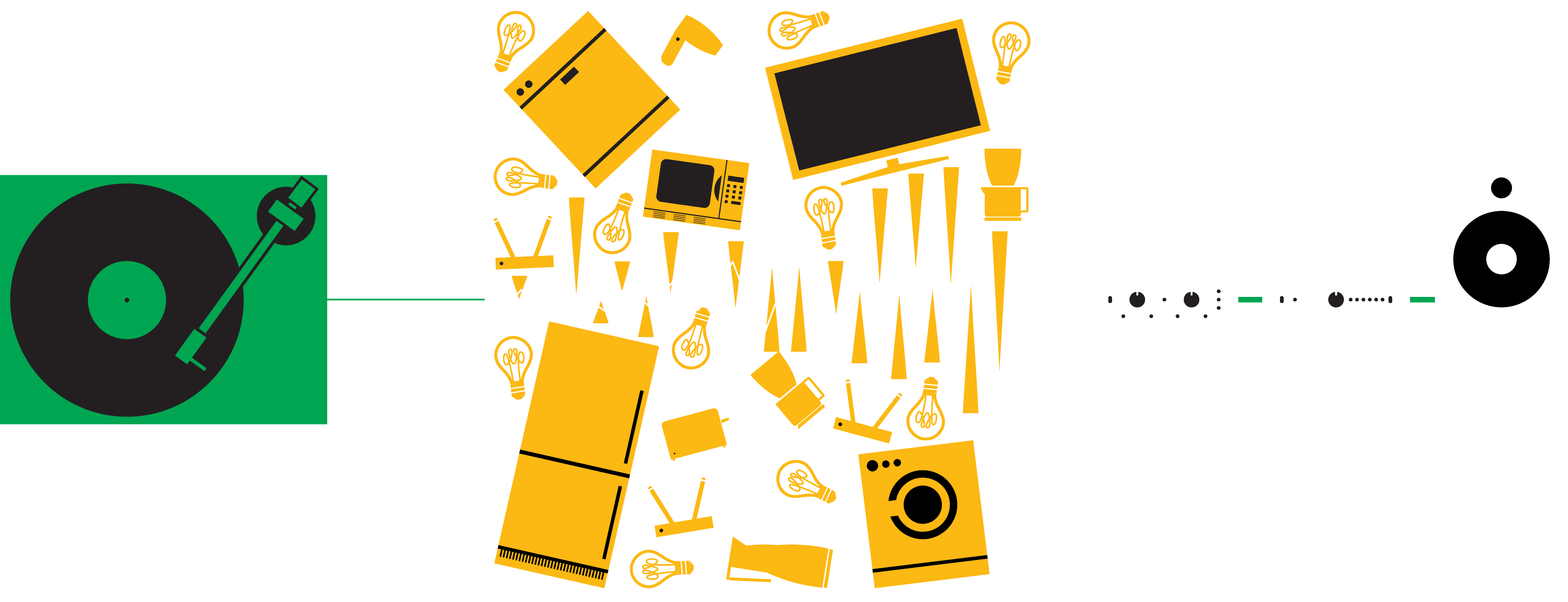
All Pro-Ject turntables are balanced signal sources by their nature, but the ability to exploit this beneficial technology has traditionally only been available to more high-end or bespoke analogue systems. Pro-Ject’s True Balanced Connection concept intends to extend these benefits to a broader variety of vinyl enthusiasts than ever before.

Depending on the output voltage of your pick-up cartridge, the typical output level from a turntable is many hundreds of times smaller (sometimes even over 1,000 times smaller) than that of a Line level source, like a typical CD player or streamer. When we pass this basic analogue signal through an RCA cable to a phono stage it is subjected to the various electronic forces that are present in our modern living environments. Powerful electronic devices, like kitchen appliances, as well as wireless routers, Bluetooth transmitters and other devices, can all contribute to an "electrosmog" that can introduce noise problems to your turntable's sensitive low-level signal.
Pro-Ject's True Balanced Connection concept has drawn inspiration from professional audio experts, who all make use of balanced audio connections for a reliable, rock-solid performance in their high-pressure environments like live concert venues and recording studios. The cable configurations used in these environments are able to remove picked-up noise from the signal path, resulting in an interference-free signal with increased dynamics and an overall lower noise level.
Unbalanced RCA cables, like those most commonly found in turntable systems, work in the following way...

An Unbalanced connection (Yellow boxes show sections with interference)

A Balanced connection has double the wires, which will each pick up the audio interference
Balanced (typically XLR) cable connections double the wires carrying the musical signal – with one side inverted. In this case noise still gets picked up by both wires, but with one side reversed. When the signals are re-joined at the phono stage, the picked-up noise is cancelled out by the opposing signals. The benefit of this is a louder, cleaner musical signal that has doubled in size with almost no remaining noise.

Balanced connection wires with one side inverted, to cancel out interference

The resulting signal after inversion

Your turntable system needs the following components in order to make use of true balanced connection technology:
Once all these requirements are met it's possible to achieve the most technically correct means of vinyl signal transfer, resulting in an improved musical output that's free of noise and interference.
READ MORE ABOUT THE BENEFIT OF TRUE BALANCED CONNECTIONS HERE
To help you understand how to build your own True Balanced front-end, we've put together some suggestions below for you.
This is a great way to update your Debut EVO 2 or other modern Debut turntable to "True Balanced" status. The logic used here also works for other older models such as the Debut Carbon, 1 Xpression, RPM 5, X1, X2, 2 Xperience, and other premium turntables with RCA outputs.
In almost all cases with this level of turntable, you will need to make sure you have a balanced ready cartridge. The most affordable way to do that is typically with the Pick it Pro Balanced, but you could also consider an MC cartridge depending on your budget and turntable model.
Here we've selected our iconic Debut EVO 2, but this system could work with many other good-quality RCA-equipped turntables.
For turntables where you have an RCA output, this cable takes the RCA connections, plus the Ground lead terminal, and connects each contact point to the 5-pins on the MiniXLR connector to cleverly adapt an RCA output to a True Balanced output.
The Phono Box S3 B is our most affordable True Balanced phono stage. Simply connect the cable into the MiniXLR input, and even if you use the RCA outputs for the rest of your system you've still benefited from all the improvements of a True Balanced vinyl front-end.
If you've already purchased one of our "B" or "BAL" turntables, like the X1 B, you will normally already have the benefit of a balanced-ready cartridge being installed and the convenience of a MiniXLR connector next to your regular RCA outputs.
This system suggestion is relevant for any of our "B" or "BAL" turntable models, but as some different cartridges are pre-installed around the world it's still important to double-check you're using a balanced-ready cartridge before proceeding.
Our MiniXLR to MiniXLR cables are the most convenient way to benefit from a True Balanced connection. Depending on your budget, you may also want to consider the higher-specified Connect it DS model.
The Phono Box DS3 B is a very high-quality fully-balanced phono stage that doesn't cost a fortune. It's great for this type of "affordable high-end" system.
For the best performance possible a number of high-end turntables are finished with a 5P TAC connector on the bottom of the arm, giving a more direct connection between arm and cable. This is true for such prestigious models as the Signature, Xtension, and the higher-end RPM models.
Here we've chosen the X8, which is supplied as standard with a good quality moving coil cartridge. However, if your turntable is not supplied with a cartridge in the box, make sure you're buying a good quality MC model. We can give you some great advice on bundle cartridge options.
For a premium system you want to ensure you get a good quality cable, so the DS-level 5P > XLR option is a sensible option. For even better performance consider the RS-level cable with its silver-core construction.
The Tube Box DS3 B can take MiniXLR or XLR inputs, and its valve stage adds a wonderful warmth to the sound - alongside its already extensive features. For even better performance consider our flagship Phono Box RS2 phono stage.
Please Note: Balanced Connections are not the same thing as "fully balanced" devices. The benefit of the above is in transporting the musical signal from the turntable to the phono stage in the most efficient and high quality manner possible. Look out for fully-balanced electrical devices separately.